UUX Evaluation of a Digitally Advanced Human–Machine Interface for Excavators
Abstract
:1. Introduction
1.1. Challenges on the Digital Construction Site
1.2. Chances and Challenges of Novel Concepts of Machine Operation
1.3. Subject of Research
2. Related Work
2.1. Usability and User Experience (UUX)
2.2. UUX Measurement
3. Aims of the Study
- The first goal is an in-depth comparison of two different ways of using the novel HMI. Therefore, the sample will be split into two groups and differences in UUX measures will be tested.
- Secondly, the performances of both groups will be tested over the course of trials to investigate possible differences in detail.
- The third goal is to interpret measures of UUX against existing benchmark values.
- Fourth and finally, we will use the gathered data to analyse correlations between measures of UUX.
4. Methods
4.1. A Novel Human–Machine Interface (HMI) Concept for Excavator Operation
4.2. Sample
4.3. Experimental Setup
4.4. Procedure
4.5. Data Analysis
5. Results
5.1. Group Differences
5.2. Performance over Trials
5.3. Benchmark Comparisons
5.4. Correlations between UUX Measures
6. Discussion
6.1. Group Differences and Interaction Modalities
- Efficiency—the new complex functions (intelligent tools, automated sub-functions) and their more extensive operation contrast with the usual direct and clear operation of conventional excavators. We expect better values for the perceived efficiency when operators build up some knowledge about the systems architecture. But clearly, there is open potential in reducing the perceived complexity of the system.
- Dependability—the evaluated prototype had a noticeable latency which may play a role here. Scepticism about digital systems and interfaces that seems quite complex at first sight may strengthen the doubt in dependability. This effect will shrink through long-term learning and the growing experience with the systems.
- Novelty—the display interface is used to associate comparable solutions from the consumer sector (tablets, smartphones, navigation systems in private health insurance) which, on the one hand, generally have a higher level of development and, on the other hand, need to map less complex tasks.
6.2. Limitations and Future Work
6.3. Conclusions and Hints for Adjusting the HMI Concept
Author Contributions
Funding
Acknowledgments
Conflicts of Interest
Appendix A. Correlations
| Time Per Task | Actions Per Task | Time Per Action | NASA-TLX (Global Workload) | SUS | UEQ | INTUI | |||||||
|---|---|---|---|---|---|---|---|---|---|---|---|---|---|
| Attractiveness | Pragmatic Quality | Hedonic Quality | Intuitiveness | Effortlessness | Gut Feeling | Magical Experience | |||||||
| Actions per task | 0.328 | ||||||||||||
| Time per action | 0.895 ** | 0.047 | |||||||||||
| NASA-TLX | 0.238 | 0.506 * | −0.017 | ||||||||||
| SUS | 0.367 | 0.140 | 0.493 * | −0.412 | |||||||||
| UEQ | Attractive-ness | −0.037 | −0.293 | −0.177 | −0.681 ** | 0.443 | |||||||
| Pragmatic Quality | −0.183 | −0.118 | −0.060 | −0.571 * | 0.550 * | 0.716 ** | |||||||
| Hedonic Quality | −0.354 | 0.070 | −0.248 | −0.280 | 0.259 | 0.581 * | 0.774 ** | ||||||
| INTUI | Intuitive-ness | 0.207 | −0.059 | 0.334 | −0.526 * | 0.619 ** | 0.69 1 ** | 0.523 * | 0.349 | ||||
| Effortless-ness | −0.245 | −0.219 | −0.122 | −0.709 ** | 0.259 | 0.729 ** | 0.646 ** | 0.407 | 0.592 * | ||||
| Gut Feeling | −0.062 | −0.293 | 0.005 | 0.022 | 0.020 | 0.026 | 0.043 | −0.101 | −0.240 | 0.033 | |||
| Magical Experience | −0.047 | −0.033 | 0.020 | −0.084 | 0.070 | 0.222 | 0.140 | 0.332 | 0.107 | 0.047 | 0.333 | ||
| Verbalization | 0.235 | 0.188 | 0.250 | −0.123 | 0.221 | 0.173 | 0.361 | 0.365 | 0.247 | 0.363 | −0.288 | −0.007 | |
References
- Chacko, V.; Yu, H.; Cang, S.; Vladareanu, L. State of the art in excavators. In Proceedings of the 2014 International Conference on Advanced Mechatronic Systems, Kumamoto, Japan, 10–12 August 2014; pp. 481–488. [Google Scholar]
- Gorecky, D.; Schmitt, M.; Loskyll, M. Mensch-Maschine-Interaktion im Industrie 4.0-Zeitalter. In Industrie 4.0 in Produktion, Automatisierung Und Logistik; Bauernhansl, T., ten Hompel, M., Vogel-Heuser, B., Eds.; Springer: Wiesbaden, Germany, 2014. [Google Scholar]
- Persson, D. Surveying in the Construction Industry-A study of Surveying and Machine Guidance Systems in Excavators on Ground Construction Projects. Master’s Thesis, Chalmers University of Technology, Göteborg, Sweden, 2018. [Google Scholar]
- Dunston, P.S.; Proctor, R.W.; Wang, X. Challenges in evaluating skill transfer from construction equipment simulators. Theor. Issues Ergon. Sci. 2011, 15, 354–375. [Google Scholar] [CrossRef]
- Wallmyr, M.; Sitompul, T.A.; Holstein, T.; Lindell, R. Evaluating Mixed Reality Notifications to Support Excavator Operator Awareness. In IFIP Conference on Human-Computer Interaction; Springer Science and Business Media: Berlin, Germany, 2019; pp. 743–762. [Google Scholar]
- Kontogiannis, T.; Embrey, D. A user-centred design approach for introducing computer-based process information systems. Appl. Ergon. 1997, 28, 109–119. [Google Scholar] [CrossRef]
- Härter, H. Touch-Display: Bedienelemente Auf Dem Display Blind Auffinden. Available online: https://www.elektronikpraxis.vogel.de/touch-display-bedienelemente-auf-dem-display-blind-auffinden-a-807732/ (accessed on 13 August 2020).
- Costes, A.; Danieau, F.; Argelaguet, F.; Guillotel, P.; Lecuyer, A. Towards Haptic Images: A Survey on Touchscreen-Based Surface Haptics. IEEE Trans. Haptics 2020, 1. [Google Scholar] [CrossRef] [PubMed]
- Butz, A.; Kruger, A. Mensch-Maschine-Interaktion; Walter de Gruyter GmbH: Berlin, Germany, 2017. [Google Scholar]
- Sakaida, Y.; Chugo, D.; Yamamoto, H.; Asama, H. The analysis of excavator operation by skillful operator-extraction of common skills. In Proceedings of the 2008 SICE Annual Conference, Tokyo, Japan, 20–22 August 2008; pp. 538–542. [Google Scholar]
- Werfel, J.; Petersen, K.; Nagpal, R. Designing Collective Behavior in a Termite-Inspired Robot Construction Team. Science 2014, 343, 754–758. [Google Scholar] [PubMed]
- Akyeampong, J.; Udoka, S.; Caruso, G.; Bordegoni, M. Evaluation of hydraulic excavator Human–Machine Interface concepts using NASA TLX. Int. J. Ind. Ergon. 2014, 44, 374–382. [Google Scholar] [CrossRef]
- Sitompul, T.A.; Wallmyr, M. Using Augmented Reality to Improve Productivity and Safety for Heavy Machinery Operators: State of the Art. In Proceedings of the 17th International Conference on Virtual-Reality Continuum and Its Applications in Industry, Brisbane, Australia, 14–16 November 2019; pp. 1–9. [Google Scholar] [CrossRef] [Green Version]
- DIN, E. Ergonomische Anforderungen für Bürotätigkeiten mit Bildschirmgeräten–Teil 11: Anforderungen an die Gebrauchstauglichkeit; Leitsätze; ISO 9241-11: 1998; Beuth: Berlin, Germany, 1998. [Google Scholar]
- Richter, M.; Flückiger, M.D. Usability Engineering Kompakt: Benutzbare Produkte Gezielt Entwickeln; Springer: Berlin, Germany, 2013. [Google Scholar]
- Jordan, P.W.; Thomas, B.; McClelland, I.L. Issues for Usability Evaluation in Industry: Seminar Discussions; Informa UK Limited: London, UK, 1996; pp. 255–262. [Google Scholar]
- François, M.; Crave, P.; Osiurak, F.; Fort, A.; Navarro, J. Digital, analogue, or redundant speedometers for truck driving: Impact on visual distraction, efficiency and usability. Appl. Ergon. 2017, 65, 12–22. [Google Scholar] [CrossRef] [PubMed] [Green Version]
- Hassenzahl, M. The Interplay of Beauty, Goodness, and Usability in Interactive Products. Hum. Comput. Interact. 2004, 19, 319–349. [Google Scholar] [CrossRef]
- Hassenzahl, M.; Diefenbach, S.; Göritz, A. Needs, affect, and interactive products—Facets of user experience. Interact. Comput. 2010, 22, 353–362. [Google Scholar] [CrossRef]
- Anderson, S.P. Creating Pleasurable Interfaces. Getting from Tasks to Experiences 2006. Available online: http://poetpainter.com/thoughts/file_download/7 (accessed on 8 January 2019).
- Woelfel, C.; Krzywinski, J.; Drechsel, F. Knowing, reasoning and visualizing in industrial design. Knowl. Eng. Rev. 2013, 28, 287–302. [Google Scholar] [CrossRef]
- Rissanen, M.J.; Rönkkö, K.; Tripathi, S. Understanding Industrial User Experience. An Excerpt from 1st International Workshop on Industrial User Experience. In 3rd International Conference on Human Computer Interaction 2011; Tripathi, S., Ed.; ACM: New York, NY, USA, 2011; pp. 75–78. [Google Scholar]
- Zeiner, K.M.; Burmester, M.; Haasler, K.; Henschel, J.; Laib, M.; Schippert, K. Designing for Positive User Experience in Work Contexts: Experience Categories and their Applications. Hum. Technol. 2018, 14, 140–175. [Google Scholar] [CrossRef]
- Wölfel, C.; Krzywinski, J. Human Needs as the Crux of the Matter in Product-Service Systems Development. In Human Behaviour in Design: Proceedings of the 2nd SIG conference; Institut für Technische Produktentwicklung, Universität der Bundeswehr München: Neubiberg, Germany, April 2019; pp. 47–62. [Google Scholar]
- Kun, C.T.; Sahari, N. Utilitarian or Experiential? An Analysis of Usability Questionnaires. Int. J. Comput. Theory Eng. 2015, 7, 167–171. [Google Scholar]
- Wölfel, C.; Krzywinski, J. Ansatz und Modell der User Experience cyber-physischer Systeme in professionellen Kontexten und dessen Kommunikation in Industriegüterunternehmen. In Arbeit interdisziplinär: Analysieren-bewerten-gestalten; Dokumentation des 65; Arbeitswissenschaftlichen Kongresses vom 27.02. bis 01.03.2019: Dortmund, Germany, 2019. [Google Scholar]
- Hart, S.G.; Staveland, L.E. Development of NASA-TLX (Task Load Index): Results of Empirical and Theoretical Research. In Advances in Psychology; Elsevier: Amsterdam, The Netherlands, 1988; Volume 52, pp. 139–183. [Google Scholar]
- Minge, M.; Riedel, L. meCUE—Ein modularer Fragebogen zur Erfassung des Nutzungserlebens. In Mensch & Computer; Boll, S., Maaß, S., Malaka, R., Eds.; Interaktive Vielfalt; Oldenbourg Verlag: München, Germany, 2013; pp. 89–98. [Google Scholar]
- Hassenzahl, M.; Burmester, M.; Koller, F. AttrakDiff: Ein Fragebogen zur Messung wahrgenommener hedonischer und pragmatischer Qualität. In Mensch & Computer; Szwillus, G., Ziegler, J., Eds.; Berichte des German Chapter of the ACM; Vieweg+Teubner Verlag: Wiesbaden, Germany, 2003; Volume 57. [Google Scholar] [CrossRef]
- Brooke, J. SUS: A Quick and Dirty Usability Scale. Usability in Industry Evaluation; Taylor & Francis: London, UK, 1996; pp. 207–212. [Google Scholar]
- Ullrich, D.; Diefenbach, S. Intui. Exploring the Facets of Intuitive Interaction. In Mensch & Computer 2010: Interaktive Kulturen 2010; Oldenbourg Verlag: Munich, Germany, 2010. [Google Scholar]
- Laugwitz, B.; Held, T.; Schrepp, M. Construction and Evaluation of a User Experience Questionnaire. In Symposium of the Austrian HCI and Usability Engineering Group; Springer: Berlin/Heidelberg, Germany, 2008; pp. 63–76. [Google Scholar]
- Alberola, C.; Brau, H.; Walter, G. Die Kürzung des User Experience Questionnaire UEQ. In Mensch Und Computer 2017-Tagungsband; Spielend Einfach Interagieren: Norderstedt, Germany, 2018; Volume 17, p. 37. [Google Scholar]
- Sanders, E.B.-N.; Stappers, P.J. Probes, toolkits and prototypes: Three approaches to making in codesigning. CoDesign 2014, 10, 5–14. [Google Scholar] [CrossRef]
- Fiorineschi, L.; Rotini, F. Unveiling the Multiple and Complex Faces of Fidelity. In The Design Society: International Conference on Engineering Design; Cambridge University Press: Cambridge, UK, 2019; Volume 1, pp. 1723–1732. [Google Scholar]
- De Winter, J.C.; Gosling, S.D.; Potter, J. Comparing the Pearson and Spearman correlation coefficients across distributions and sample sizes: A tutorial using simulations and empirical data. Psychol. Methods 2016, 21, 273–290. [Google Scholar] [CrossRef]
- Grier, R.A. How High is High? A Meta-Analysis of NASA-TLX Global Workload Scores. Proc. Hum. Factors Ergon. Soc. Annu. Meet. 2015, 59, 1727–1731. [Google Scholar] [CrossRef]
- Bangor, A.; Kortum, P.; Miller, J. Determining what individual SUS scores mean: Adding an adjective rating scale. J. Usability Stud. 2009, 4, 114–123. [Google Scholar]
- Sampaio, A. Quantifying the user experience: Practical statistics for user research. ACM Sigsoft Softw. Eng. Notes 2013, 38, 57–58. [Google Scholar] [CrossRef]
- Lewis, J.R.; Sauro, J. Item benchmarks for the system usability scale. J. Usability Stud. 2018, 13, 158–167. [Google Scholar]
- Schrepp, M.; Hinderks, A.; Thomaschewski, J. Construction of a Benchmark for the User Experience Questionnaire (UEQ). Int. J. Interact. Multimed. Artif. Intell. 2017, 4, 40. [Google Scholar]
- Hart, S.G. NASA-task load index (NASA-TLX); 20 years later. Proc. Hum. Factors Ergon. Soc. Annu. Meet. 2006, 50, 904–908. [Google Scholar] [CrossRef] [Green Version]
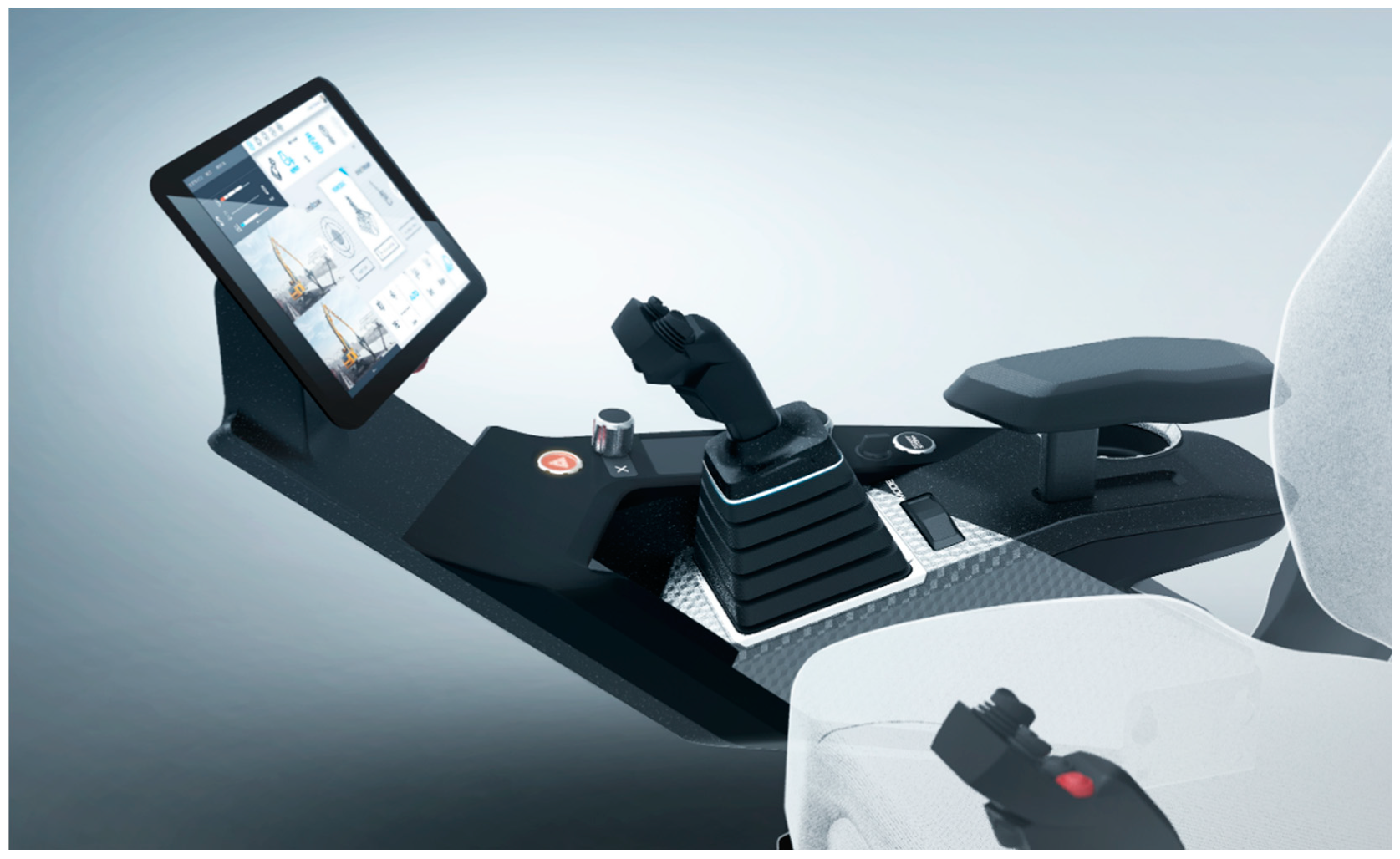
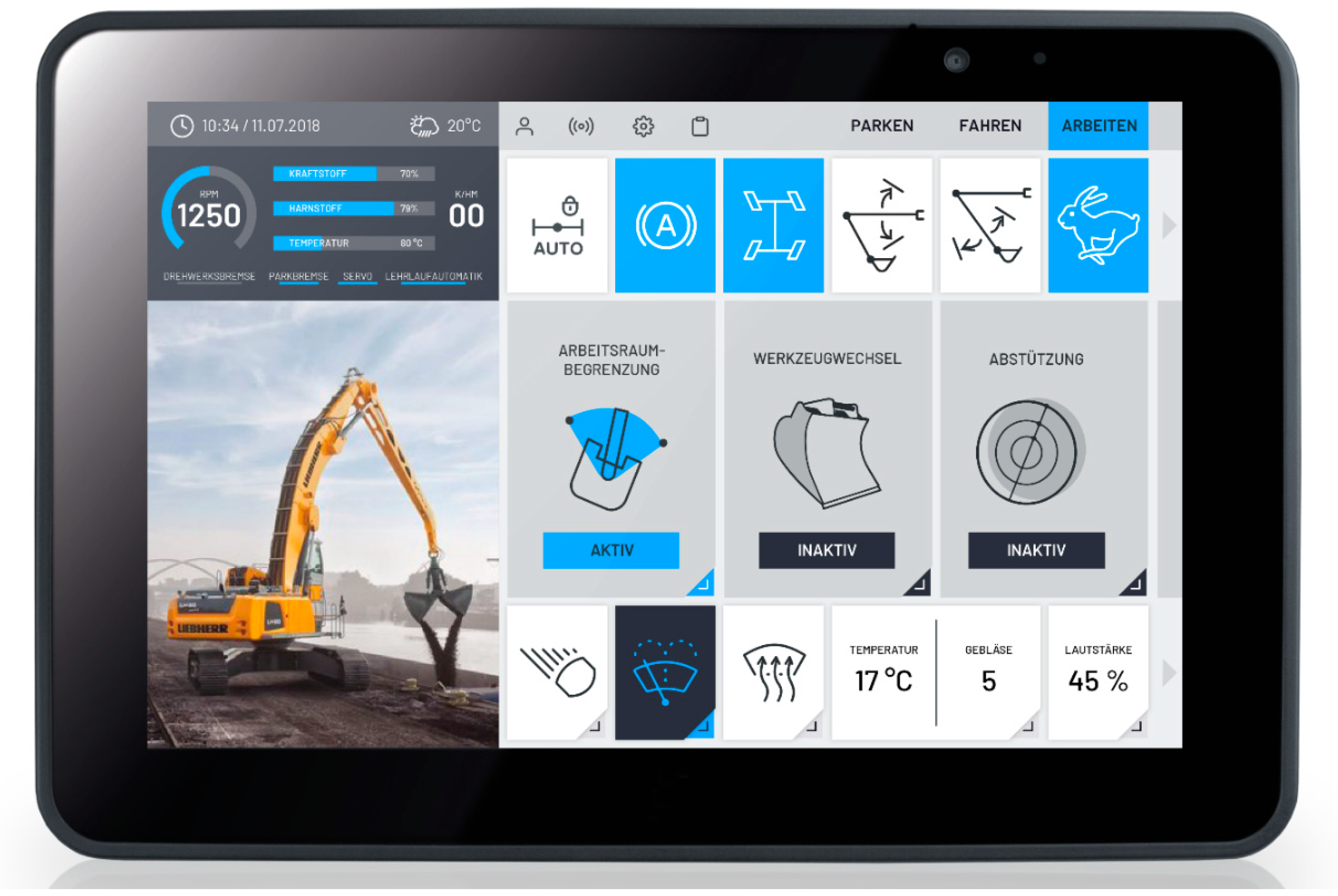
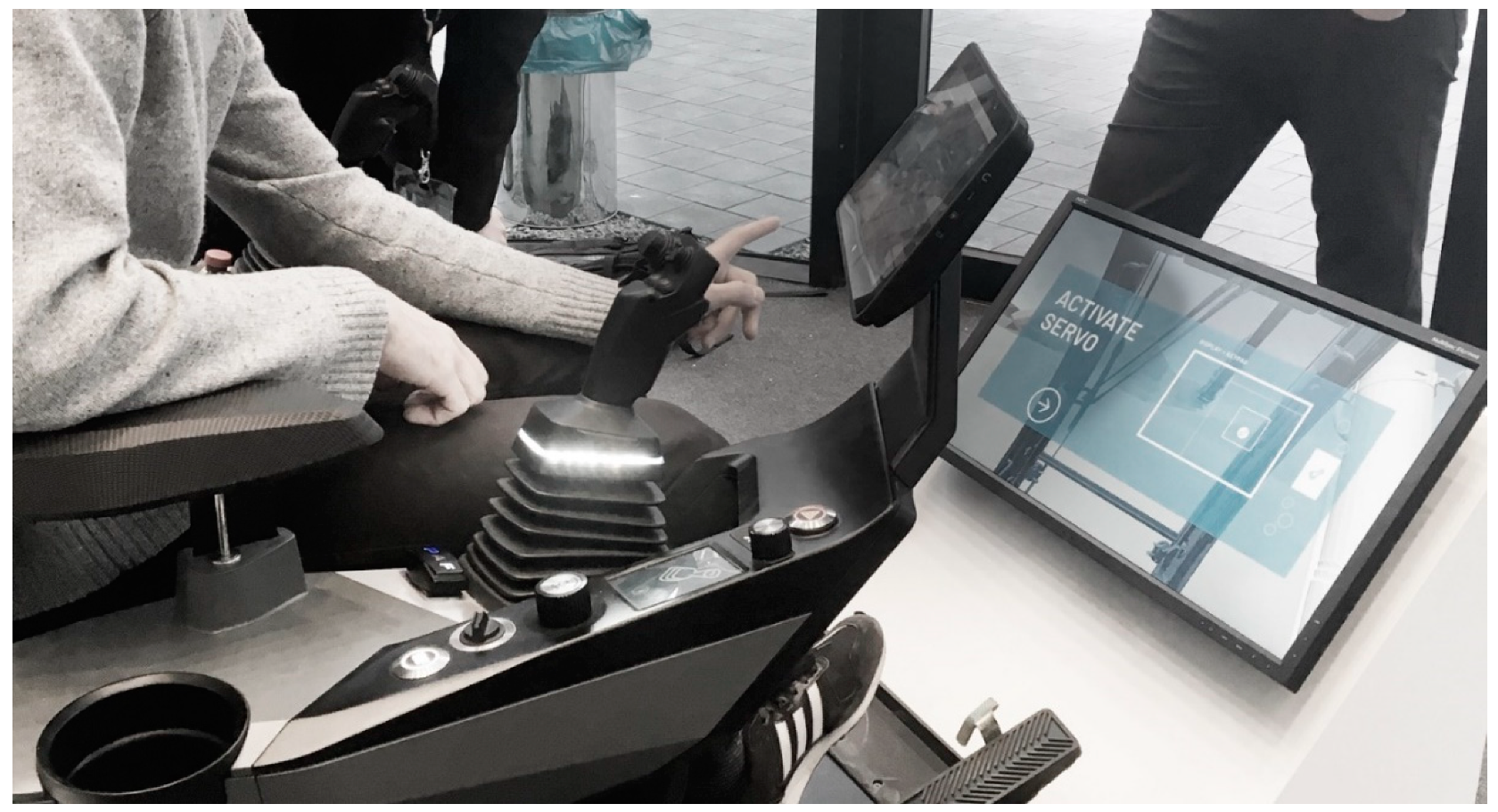
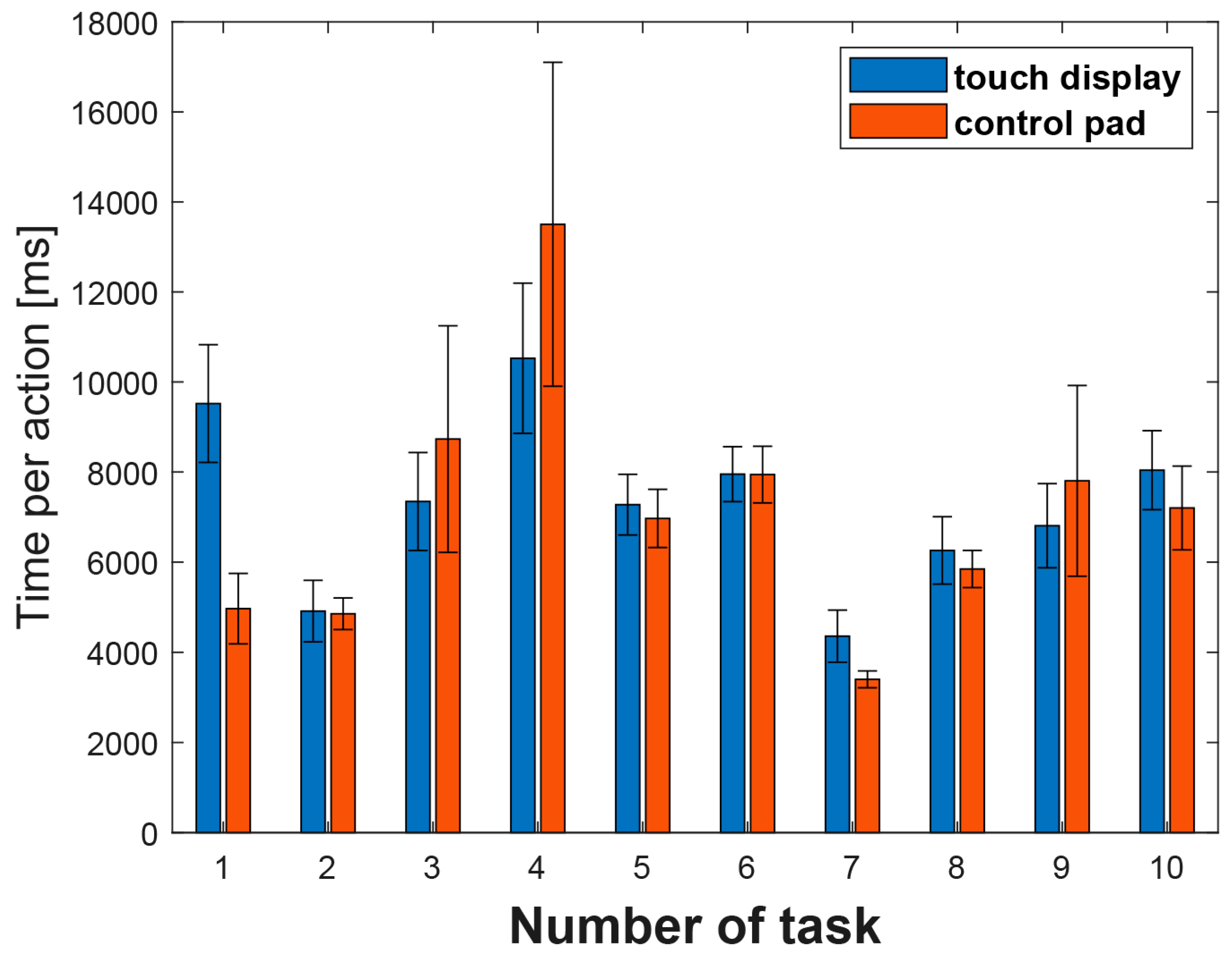
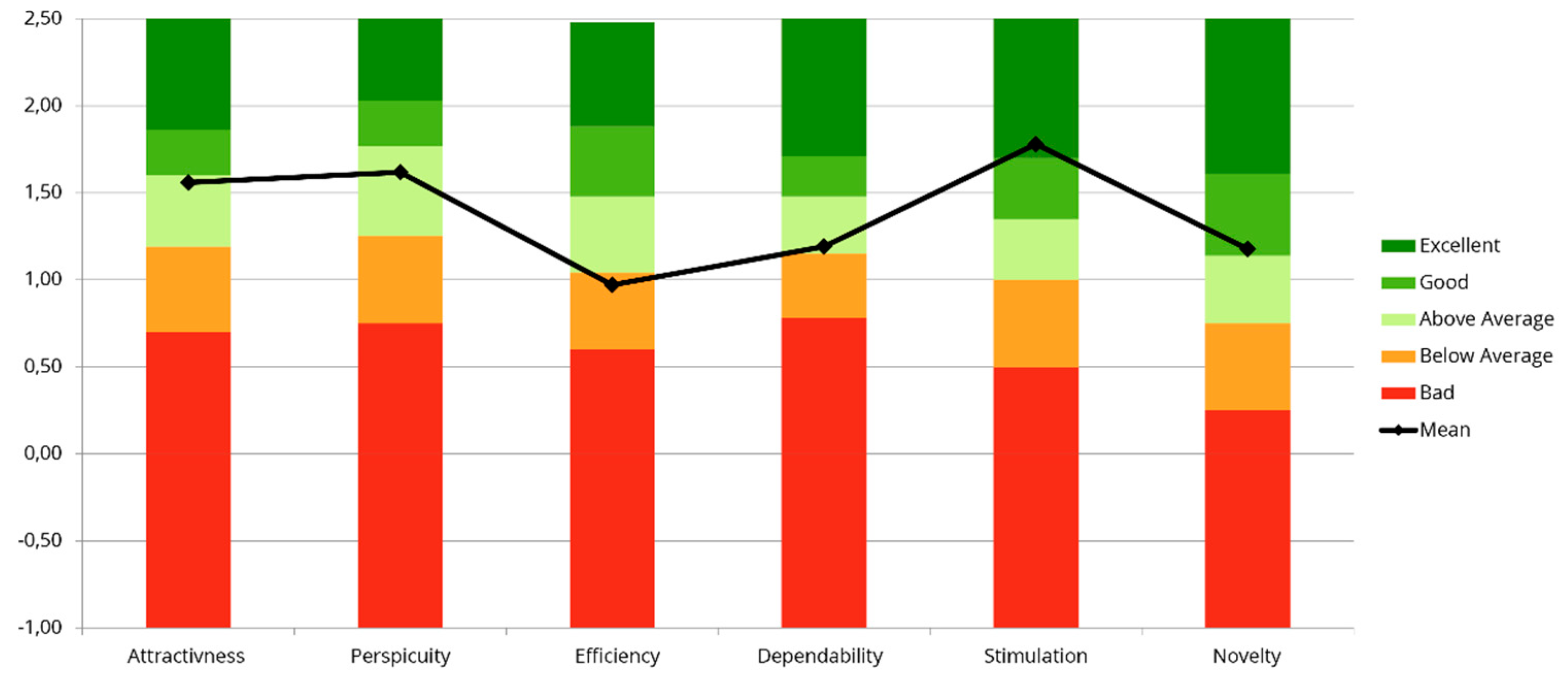
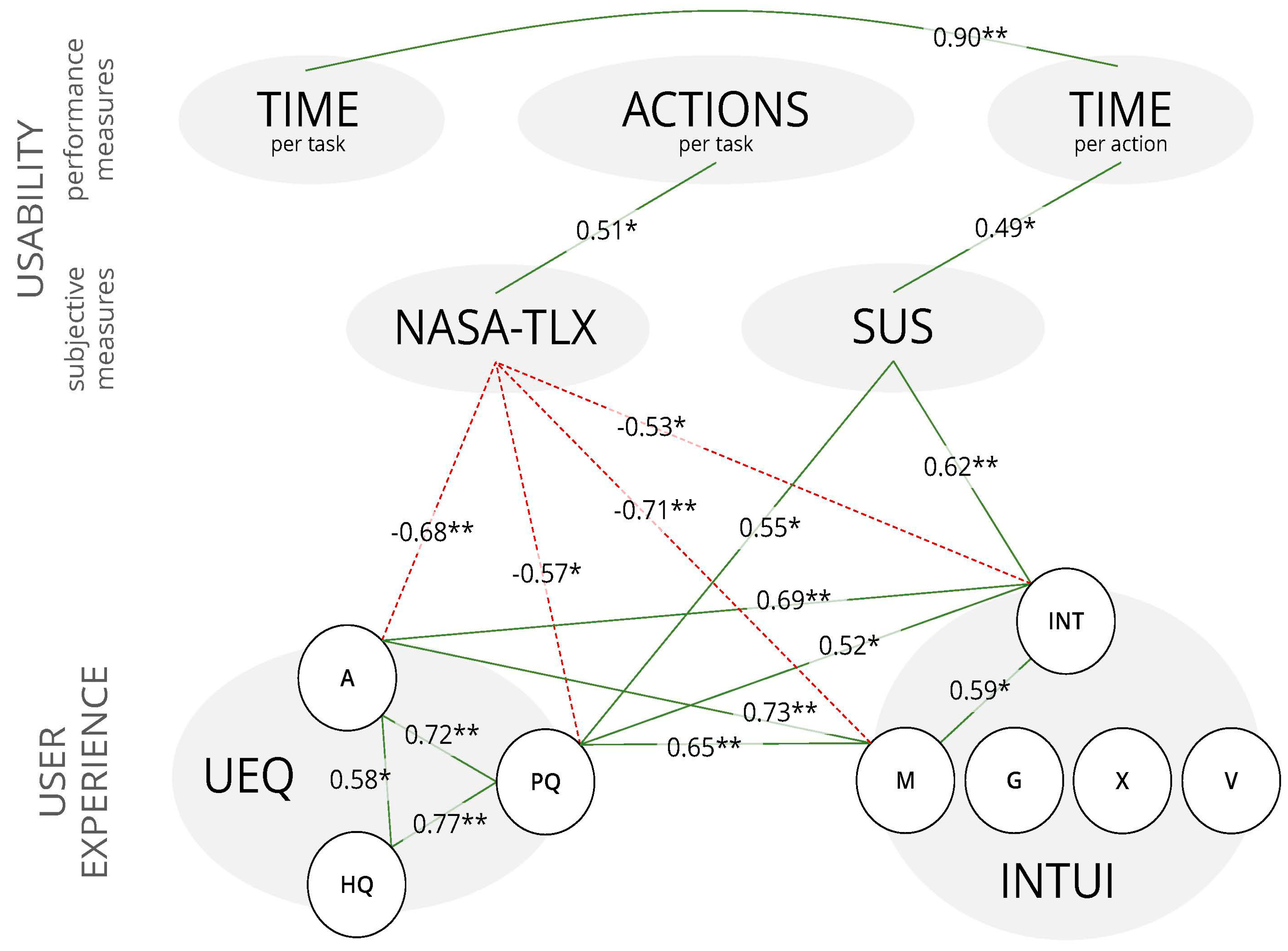
| Measure | Control Pad | Touch Display | t-Value t (15) | p |
|---|---|---|---|---|
| (1) Demographics | ||||
| Age | 18.5 (1.07) | 18.9 (2.67) | 0.385 | 0.706 |
| ATI | 4.6 (0.35) | 4.6 (0.31) | 0.019 | 0.985 |
| (2) Usability | ||||
| Time per task | 17.2 s (4.96 s) | 17.1 s (5.33 s) | 0.049 | 0.962 |
| Actions per task | 2.4 (0.30) | 2.7 (0.77) | 1.244 | 0.233 |
| Time per action | 7122 (1924) | 7300 (1414) | 0.219 | 0.830 |
| SUS | 75.3 (8.18) | 71.9 (15.50) | 0.549 | 0.591 |
| NASA-TLX | 30.8 (13.30) | 27.8 (13.00) | 0.462 | 0.651 |
| Mental | 8.3 (3.73) | 6.1 (3.06) | 1.30 | 0.214 |
| Physical | 4.9 (5.36) | 6.0 (4.66) | 0.463 | 0.650 |
| Temporal | 4.9 (2.59) | 4.3 (2.74) | 0.418 | 0.682 |
| Performance | 8.5 (5.86) | 7.4 (4.59) | 0.416 | 0.683 |
| Effort | 6.8 (3.11) | 5.8 (4.60) | 0.503 | 0.622 |
| Frustration | 3.6 (4.93) | 3.7 (3.80) | 0.020 | 0.985 |
| (3) User Experience | ||||
| INTUI | ||||
| Effortlessness | 5.2 (0.55) | 5.1 (1.27) | 0.197 | 0.847 |
| Gut Feeling | 2.8 (0.51) | 3.1 (1.04) | 0.882 | 0.392 |
| Magical Experience | 4.5 (0.53) | 5.0 (0.48) | 1.819 | 0.089 |
| Verbalisation | 5.4 (0.35) | 5.6 (1.04) | 0.378 | 0.714 |
| Intuitiveness | 5.0 (0.76) | 4.6 (1.13) | 0.939 | 0.362 |
| UEQ | ||||
| Attractiveness | 1.7 (0.54) | 1.4 (0.93) | 0.649 | 0.526 |
| Pragmatic Quality (mean of Perspicuity, Efficiency, and Dependability) | 1.4 (0.56) | 1.1 (1.00) | 0.740 | 0.471 |
| Perspicuity | 1.7 (0.43) | 1.5 (1.02) | 0.510 | 0.620 |
| Efficiency | 1.2 (0.69) | 0.8 (1.12) | 1.024 | 0.322 |
| Dependability | 1.3 (0.84) | 1.1 (0.99) | 0.510 | 0.618 |
| Hedonic Quality (mean of Stimulation and Originality) | 1.6 (0.48) | 1.3 (0.64) | 1.104 | 0.287 |
| Stimulation | 1.8 (0.51) | 1.8 (0.72) | 0.204 | 0.841 |
| Originality | 1.5 (0.56) | 0.9 (0.71) | 1.770 | 0.097 |
© 2020 by the authors. Licensee MDPI, Basel, Switzerland. This article is an open access article distributed under the terms and conditions of the Creative Commons Attribution (CC BY) license (http://creativecommons.org/licenses/by/4.0/).
Share and Cite
Lorenz, S.; Helmert, J.R.; Anders, R.; Wölfel, C.; Krzywinski, J. UUX Evaluation of a Digitally Advanced Human–Machine Interface for Excavators. Multimodal Technol. Interact. 2020, 4, 57. https://doi.org/10.3390/mti4030057
Lorenz S, Helmert JR, Anders R, Wölfel C, Krzywinski J. UUX Evaluation of a Digitally Advanced Human–Machine Interface for Excavators. Multimodal Technologies and Interaction. 2020; 4(3):57. https://doi.org/10.3390/mti4030057
Chicago/Turabian StyleLorenz, Sebastian, Jens R. Helmert, Ruben Anders, Christian Wölfel, and Jens Krzywinski. 2020. "UUX Evaluation of a Digitally Advanced Human–Machine Interface for Excavators" Multimodal Technologies and Interaction 4, no. 3: 57. https://doi.org/10.3390/mti4030057
APA StyleLorenz, S., Helmert, J. R., Anders, R., Wölfel, C., & Krzywinski, J. (2020). UUX Evaluation of a Digitally Advanced Human–Machine Interface for Excavators. Multimodal Technologies and Interaction, 4(3), 57. https://doi.org/10.3390/mti4030057




